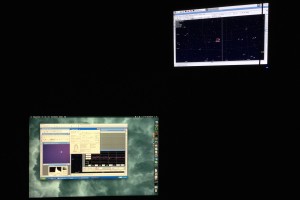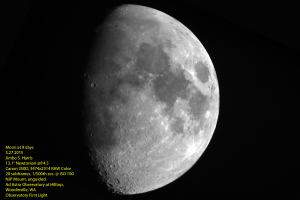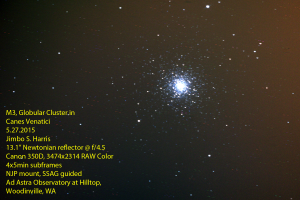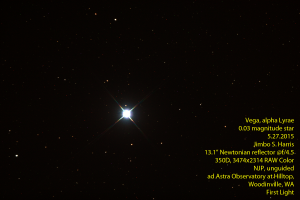We did it!
It’s been a long hard journey, with lessons learned, and ducks carefully put into rows. Four years of design and development all came together tonight.

The sky was even clearer tonight than it was yesterday, and with just a couple of hiccups and knocking some more rust off of my workflow, I was out shooting before sunset.
The moon is a huge, bright target, so it’s usually the one that gets a few “test” shots before the real work begins. It’s beautiful, as always, but I just can’t take a full-disc lunar photo all that seriously; it wasn’t even dark when I captured this.

I will put the nitty gritty technical details in another post — this is about the realization of a dream.
With a decently-focused photo of the moon on the drive, I knew that I was ready to go, once the sky got dark. The moon was going to be up all night (it was still up at 2am when I shut down), so that helped me to select a target for the evening; because bright moonlight washes out faint nebular detail, I knew that going after a galaxy (which is primarily what’s in the sky at sunset right now) would be disappointing; still time to catch the spring galaxies next week, when the “Astrophotography Moon” is in the sky (or *not* in the sky, if you catch my meaning). So I decided that First Light for the Ad Astra Observatory at Hilltop was going to have to be a star cluster of some kind, and globular clusters are also abundant at this time of year, so I went for a pretty famous one, M3. This cluster of about half a million stars sits some 33,000 light years away (the light I captured left there about 20,000 years before we domesticated the dog).
There are ancient photons inside my computer again.

After M3, I stopped in to focus the camera. I like to use bright stars to focus on, and this time I used Vega, who threw out some really pretty diffraction spikes off of my spider (when the diffraction spikes are sharpest, you have reached best focus; bonus!). Beauty and brains, killer combo.

Once I was focused, I made a final stop for the evening at M57, and captured about 90 minutes of data, but I had to shut down and go to bed before processing it. Tomorrow. Sleep first.
Of course there is still tuning to be done, but this is just the fun part. This is where I actually get to show off. We just made the first step on a new journey.
Welcome to the Sky, Hilltop Observatory. Keep looking up.


Boom!!! It is soo amazing!!!